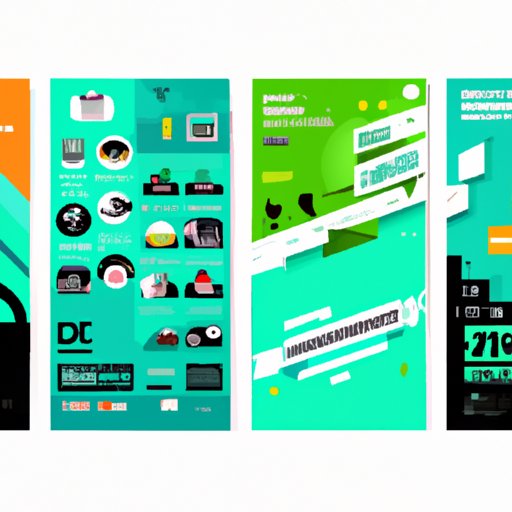Introduction
If you’re a designer or someone who works in the creative field, you’ve probably heard of flat design before. In recent years, this design trend has become incredibly popular, and today, it’s used by companies of all sizes to create everything from logos to websites to mobile apps. But what exactly is flat design? And why should you consider using it in your next project?
Defining the Term: A Beginner’s Guide to Understanding Flat Design
Put simply, flat design is a minimalist approach to design that uses simple shapes, clean lines, and bright colors to create a visual aesthetic that’s both modern and functional. Unlike other design styles, which often use shading, texture, and other effects to create depth and dimension, flat design relies on simple elements arranged in a concise and logical way.
At its core, flat design is all about making information easy to understand. By removing unnecessary elements and simplifying each component of a design, flat design allows users to navigate information quickly and efficiently. This is why flat design is so popular in digital contexts, where users’ attention spans are notoriously short.
Characteristics of Flat Design:
- Simple shapes and geometry
- Bold, bright colors
- Clean lines and typography
- Minimal or no use of shading, gradients, or textures
- Focus on functionality
- User-centered design
Historical Context:
Although flat design is often associated with contemporary design trends, its roots actually stretch back to the early days of graphic design. In the mid-20th century, designers like Massimo Vignelli and Saul Bass began experimenting with minimalist design that relied on clean lines, simple shapes, and bold typography. These early flat designs helped set the stage for the functional, user-centered designs that dominate the digital landscape today.
The Evolution of Flat Design: From Origins to Modern Applications
In the early days of web design, skeuomorphic design was the norm. Skeuomorphism is a design approach that imitates physical materials and textures in the digital space. For example, skeuomorphic design might use realistic-looking leather textures and shadow effects to make an on-screen button look like a real button you could press in the physical world.
However, as web design and mobile app design evolved, designers began to realize that skeuomorphic design wasn’t always the best approach. These designs could be overly complex, making it harder for users to understand how to interact with digital products. Flat design was introduced as an antidote. By relying on simple shapes, clean lines, and bold colors, flat design made digital products look uncluttered and easy to use.
Over the years, flat design trends have evolved to include new design concepts and techniques. For example, designers might use animation effects to create visual interest and draw users’ attention to important information. Additionally, designers might use a “semi-flat” design approach that incorporates a limited amount of shading, for depth.
The Advantages and Disadvantages of Using Flat Design in Your Projects
Advantages of using flat design:
- Flat design is incredibly versatile and can be used in a wide range of design contexts, from web design to mobile app design to print design.
- Flat design is easy to read and understand, making it ideal for digital products where users need to be able to navigate information quickly.
- Flat design is modern and visually appealing, making it a popular choice for companies that want to project a contemporary brand image.
- Flat design is often easier and faster to create than other design styles that rely on complex effects and textures.
Disadvantages of using flat design:
- Flat design can be challenging for beginning designers who may not be used to working with simple shapes and bold typography exclusively.
- Flat design can feel impersonal or cold if not applied correctly, making it important to get the tone and messaging of your design right.
- Flat design can be overused and become cliche, so it’s important to find ways to make your flat design unique and memorable.
How to Create a Flat Design: Techniques and Tips for Designers
Techniques commonly used in flat design:
- Simple shapes and geometry: Use circles, squares, triangles, and other basic shapes to create your design.
- Bold, bright colors: Choose a limited number of bright colors to create visual interest and contrast.
- Clean lines and typography: Use a simple, sans-serif font for text and clean lines for graphics.
- Flat design icons: Use simple, stylized icons instead of detailed illustrations to convey concepts.
- Minimal or no use of shading, gradients, or textures: Avoid adding visual depth to your designs – everything should be flat.
Tips for designing effectively in a flat style:
- Make sure your design is aligned, with elements arranged in a logical and consistent way.
- Think about how color can convey meaning and be used to draw attention to important information.
- Focus on how your design will function in context – what do users need to be able to do with your design, and how can you make that process as easy as possible?
- Keep it simple – if in doubt, remove elements that aren’t necessary. Flat design is all about stripping away excess and leaving only the essentials behind.
Flat vs Skeuomorphic Design: A Comparison of Two Design Approaches
Overview of skeuomorphic design:
Skeuomorphic design, as mentioned earlier, imitates physical materials and textures in the digital space. This design style was popular in the early days of web design and is still used today in some design contexts.
Comparison of flat and skeuomorphic design:
- Flat design is modern and streamlined, while skeuomorphic design can be more complex and detailed.
- Flat design is often easier to use and navigate, while skeuomorphic design can be harder to understand for users who are unfamiliar with physical objects that their digital counterparts are based on.
- Flat design can be more versatile and applicable in various design fields, while skeuomorphic design can sometimes feel outdated or clichéd.
The Role of Color in Flat Design: Choosing Harmonious Palettes for Your Projects
Color is an essential element of any design. In flat design, color plays an even more critical role since flat design relies on color to convey meaning, create contrast, and draw attention to important information. Here are some tips for choosing effective color palettes in flat design:
- Choose a limited number of bright, bold colors to create contrast and visual interest.
- Use color to convey meaning – for example, use green to signify success or red to signify danger.
- Experiment with color palettes until you find the combination that feels right for your design context.
- Consider using color gradient effects for depth (not often) but still recommended.

Examples of Flat Design: The Best Inspirational Work from Around the Web
If you’re looking for inspiration for your next flat design project, you’re in the right place! Here are some of the best examples of flat design from around the web:
- Stripe: This website uses bold, bright colors and clean typography to create a modern and playful look.
- Dribbble: Dribbble’s logo uses simple, rounded shapes to create a memorable visual aesthetic.
- Spotify: Spotify’s mobile app uses a clean, white interface with bold green and black accents to create a design that’s both functional and visually striking.
By studying and analyzing these designs, you can get a better sense of how to apply flat design principles to your own projects.
Conclusion
Flat design is a trend that’s here to stay, and for good reason – it’s an effective way to create functional, modern designs that users love. By following the tips and techniques outlined in this article, you’ll be well on your way to creating your own successful flat designs that stand out from the crowd.
Remember, when it comes to flat design, less is more.
